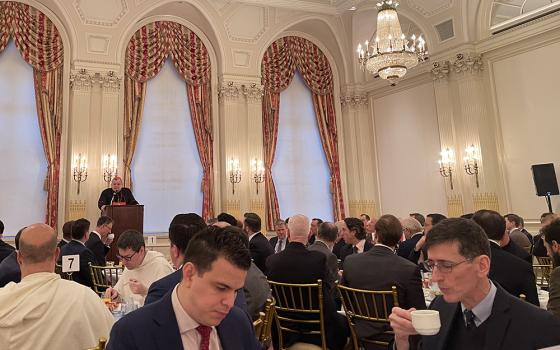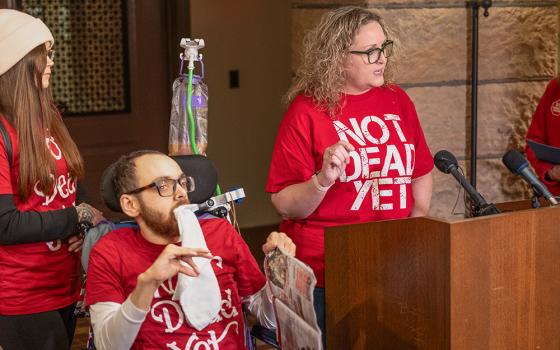We have a new winner in the sweepstakes for shortest shelf-life of any Vatican denial of a news story ever, with the nearly instantaneous retraction Jan. 17 of a statement disputing an Associated Press report that almost 400 priests had been defrocked in 2011/2012 in cases involving sexual abuse.
The denial was issued by Jesuit Fr. Federico Lombardi, the Vatican spokesman, at 9:31 pm Rome time last night and retracted at 10:32 pm, which means that it survived barely an hour.
In retrospect, the breakdown seems a classic illustration of the perils of today’s instant news cycles.
The Associated Press moved the story on Jan. 17, basing it on data prepared for the Vatican delegation at a session of the United Nations Committee on the Rights of the Child in Geneva the day before devoted to exploring the church's record on child sexual abuse.
That delegation was composed of Italian Archbishop Silvano Tomasi, the Vatican’s representative to the U.N. in Geneva, and Auxiliary Bishop Charles Scicluna of Malta, the Vatican’s former top sex abuse prosecutor. Among other materials, they had a spreadsheet with numbers of abuse cases reported to the Congregation for the Doctrine of the Faith in recent years and the dispensation of those cases, which was apparently obtained by the AP.
What the data showed was that in 2011, there were 125 cases in which laicization, meaning removal from the clerical state, was imposed as a penalty, and 135 cases in which dispensations were granted, meaning a voluntary exit from the priesthood. In 2012, the totals were 57 dismissals and 67 dispensations.
Adding it all up, that’s 384 priests who either willingly left the priesthood or were removed in those two years for reasons related to charges of abuse, which the AP story by John Heilprin and Nicole Winfield rounded up to “almost 400.”
When the story broke, other reporters (myself included) started calling Lombardi and Scicluna for comment. Lombardi’s natural instinct was to check the figures against the “Acts of the Holy See” for 2012, which is the official collection of data and reports from various Vatican departments.
What Lombardi found is that the disciplinary office of the Congregation for the Doctrine of the Faith opened 612 new cases against priests in 2012, of which 418 regarded the abuse of minors. Since the number was close to the count in the AP story, Lombardi understandably assumed that the reporters had confused opening cases with defrocking and issued his denial.
It should be said that he was facing pressure to say something from news agencies around the world, and in some ways it’s striking that he was even on the job and taking calls that late on a Friday night.
In the meantime, I and other reporters also reached out to Scicluna, who initially thought the AP report probably reflected the same confusion. Once he checked the numbers, however, he realized the story was correct, and said so to me and other reporters.
I scarcely had time to post a brief item noting Scicluna’s confirmation when the e-mail from Lombardi came through withdrawing his earlier denial.
In the old days all this would have played out away from prying eyes, because there would have been time for Lombardi and Scicluna to compare notes, check the data from Geneva, perhaps even call up one of the AP reporters to find out what their story had been based on, before making any statements.
In a media environment driven by instant blog posts and tweets, however, the confusion unfolded in full public view, causing no small amount of heartburn for those directly involved – and, probably, a degree of amusement for everyone else.
In an ideal world the AP might have called Lombardi before moving the piece and given him a chance to react, though that’s always a dicey proposition for reporters who are sitting on a good story and don’t necessarily want to give competitors a chance to beat them to the finish line by fishing around for reaction.
Three take-aways suggest themselves about the episode.
First, the AP got it right, and in the end officialdom recognized it. One could quibble about whether a voluntary dismissal from the clerical state is really tantamount to a “defrocking,” but anyway the numbers are correct.
Second, there’s no grand conspiracy behind the now-you-see-it, now-you-don’t denial from Lombardi. It was simply a function of time pressure and the coincidence that the number in the AP story and the number in the “Acts of the Holy See” were close enough to suggest a conflation between the two.
Third, the mini-drama involving the denial shouldn’t overshadow the big picture, which is that a large number of priests were removed for reasons related to abuse during the final years of Benedict’s papacy.
When the story of Benedict’s efforts to address the abuse crisis is written, we thus have a new chapter to add thanks to the Associated Press.
(Follow John Allen on Twitter: @JohnLAllenJr)




